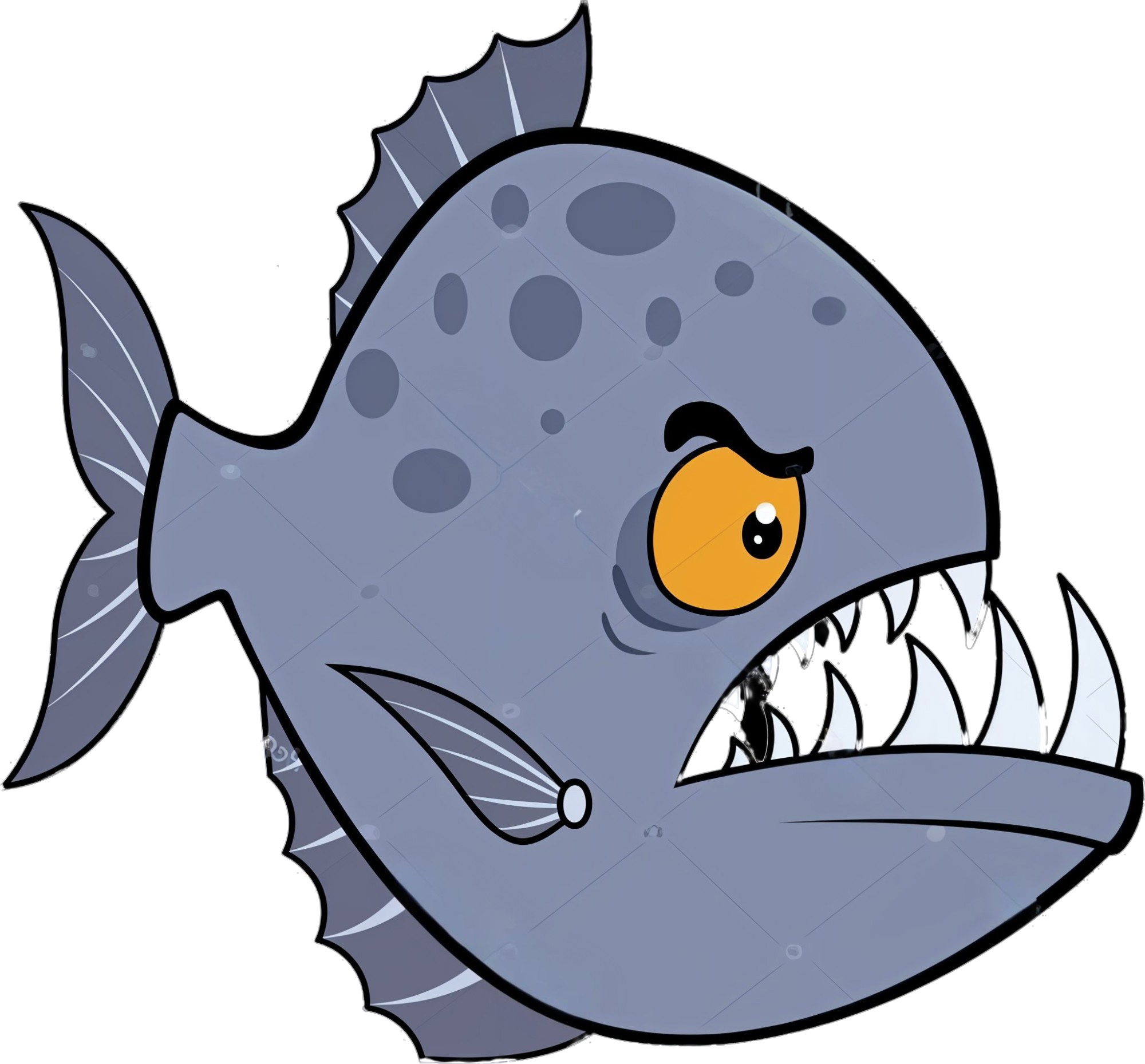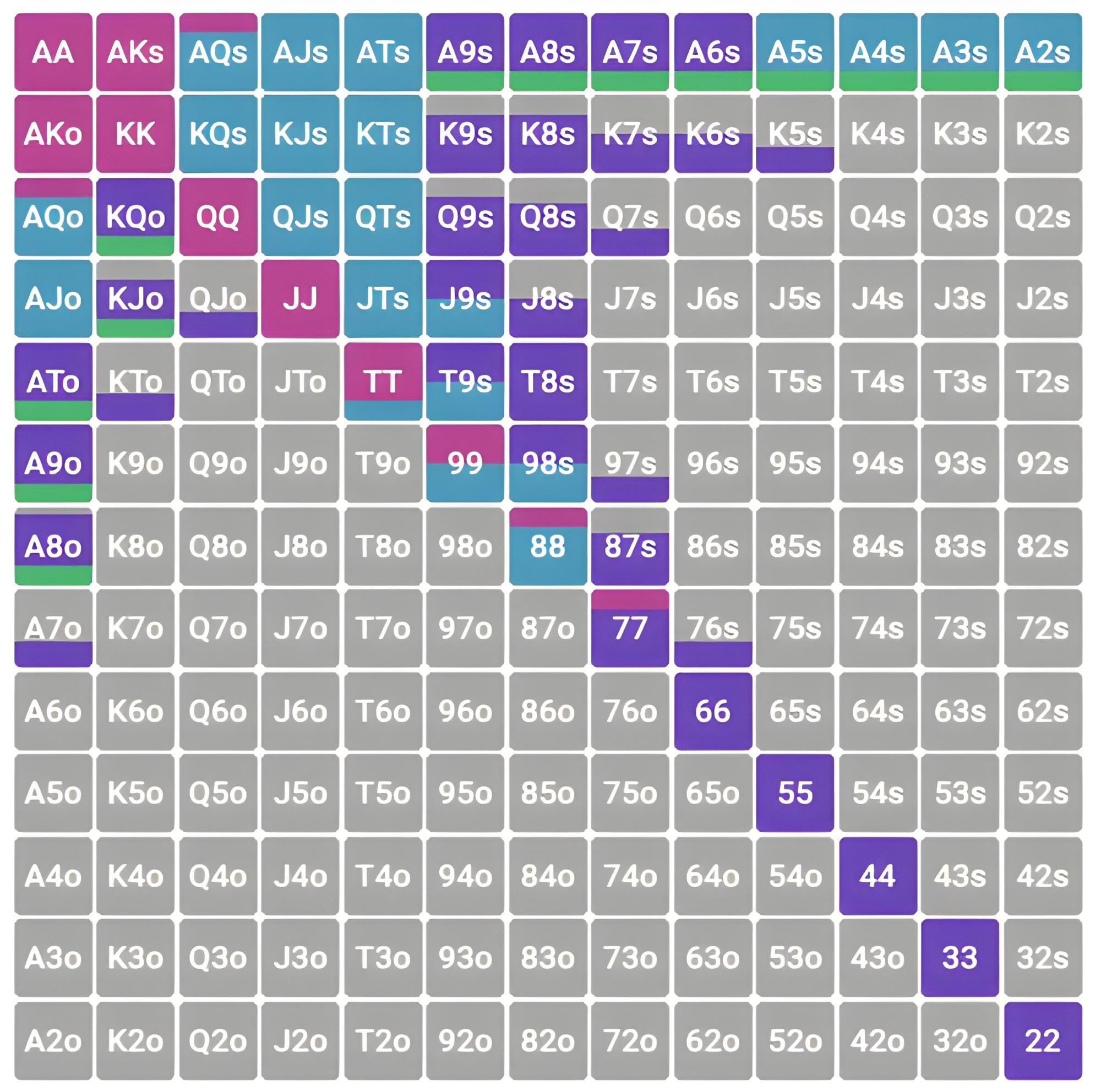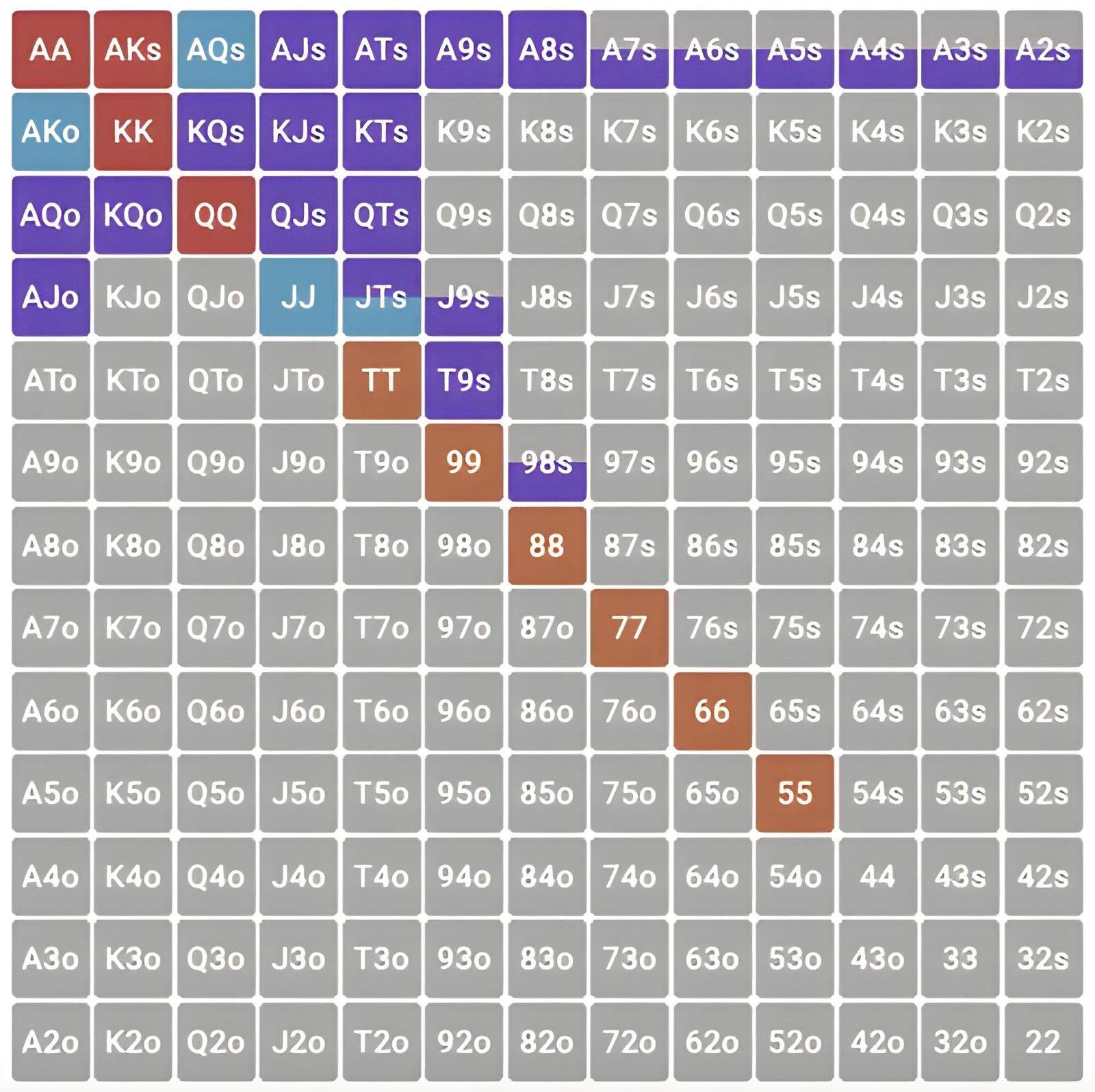Translated with the help of AI. We apologize for any errors and would appreciate your help in correcting them.
Determining the type of opponent is an important strategic task that underlies the main principle of strategic thinking in poker — the principle of narrowing the range. Players often face the difficulty of differentiating the ranges of opponents with different playing styles, and an accurate identification of the style allows them to adapt their strategy more effectively and make more profitable decisions.
1. Types of Poker Players
Criteria for determining the type of player:
The number of hands played on the preflop.
The predominant style of play is aggressive or passive.
Characteristic features: limps, mini-bets on post-flop, wide cold-call.
2. Phone (Calling Station) 
The phone is a player who often calls opponents' bet and rarely takes the initiative, especially on post-flop. Most amateurs play in this style. There are several subtypes among them.
Types of phones:
Tight phone — VPIP up to 33%. Plays a limited number of hands, but is prone to frequent calls, even in disadvantageous situations.
Regular phone — VPIP from 34% to 45%. He plays a wide range of hands, but continues to prefer calls to raises and bets.
Whale — VPIP from 45% and above. Plays almost all hands, including obviously weak ones, and is easily drawn into hands with minimal chances of winning.
Aggressive passive phone — a player who can act actively on the preflop (raises, 3-bets), but abruptly turns into a passive manner on the postflop, limiting himself to calls and check-behinds.
You can determine the phone by a number of statistical indicators:
High VPIP — more than 26%, which indicates a large number of starting hands.
Many limps and cold calls — the player often enters the pot without a raise or calls other people's openings.
Passive preflop — PFR below 18% and 3-bet less than 8%, indicating the rare use of aggressive preflop actions.
Passive post-flop is Agg below 2, meaning the player prefers to call rather than bet or raising.
What range does the average phone plays
A poker phone is a player who likes to play a wide range of hands. To simplify, he is ready to enter with almost any cards that look at least a little “beautiful”.

How to play against phones
In terms of strategy, playing against phones is a gift. These are the weakest opponents at the table, but to get the most out of it, you need to choose the right approach.
- The main rule is to reduce bluffs and be more careful with semi-bluffs. The phone doesn't like to fold cards. Even if he only has a third pair or a weak hit on the board, he will often pay to the end. This means that your bet ("velu value bet") against him works better than against anyone else.
- If you have a strong hand — put it big. Do not try to subtly “squeeze” extra chips, provoking a bluff — this is not the type of player who will decide on this before the river. Conversely, expand your range for value bets: against the phone, you can get the extract value even from the hands that you would play against other opponents through a check.
- Beware of the aggression of such players: if they start raising and dispersing the pot, this almost always means a very strong hand.
- There is one curious strategic trick against them: such players like to draw their hands to the river. If they have not collected anything, they often turn their hand into a bluff — especially if you are without a position and checked out. This can be a source of additional income if you catch the moment.
Aggressive-Passive Subtype of Phone
There is also a special subtype — an aggressive phone from preflop.
This is a kind of "evolution" of the classic phone. Such a player once realized that an aggressive game before the flop is more profitable than a passive one, and began to actively raising and 3 bet. But beyond the preflop, it still turns into an ordinary phone: the frequency of aggression (Agg) on the postflop is low, there are almost no bluffs, and the play of hands is cautious and passive. The same rules apply against such an opponent: a minimum of bluffs, a maximum of large value bets. If he shows aggression on the post-flop — take it very seriously. It will almost always be a strong finished combination.
3. maniak 
A maniak is a player who also plays a lot of hands, but does it with constant aggression and with bluffs.
He likes to bluff and often does it without proper understanding when a bluff is really beneficial. Because of this, the maniak also belongs to the category of weak players, and we are glad to see him at the table.
How to identify a maniac at the table:
VPIP above 30%;
high PFR, many 3-betas and even 4-betas on preflop;
aggressive post-flop game with a lot of bluffs (Agg > 3);
willingness to go all-in in the hands of medium strength.
-
What range does the maniak plays
The maniac's range is similar to the phone's in width, but his play is much more assertive and aggressive.

How to play against maniacs:
Maniak is a sloppy dream. Give him the opportunity to increase the pot himself, do not rush to reveal the strength of his hand. It is prone to triple barrels and “inflating” the pot from scratch, so your task is just to catch the moment.
- Narrow your range and play secretly.
- Provoke them to bluffs more often, especially on post-flop bluffs.
- Minimize your own bluffs — they do not work against people who constantly bet themselves.
- Be prepared to open them with a wider call range than against other opponents.
Due to the fact that the maniak often bluff, we should trust his strength less on both preflop and postflop. At the same time, it is important to keep yourself in control. Maniacs are good at provoking Tilt, knocking out the psychological balance. Do not give in, play disciplined and patiently, waiting for the situation when he generously pays for your strong hand.
4. nit 
Nit is the opposite of a maniac. He plays very few hands, waiting only for the best starting combinations. Everything else goes to fold.
How to recognize a nit:
- Low VPIP (<17%)
- Low 3-bet (<7%)
What range plays the nit

Strategy game against the nit:
- Ignore him before he walks into the pot.
- If the nit increases or 3-betite — drop more often, even with decent hands.
- Actively steal from his blinds.
- Pocket pairs against the nit are particularly lucrative: if you hit the set, it will often pay you with its strong pair.
Nits almost do not bluff. If they made a cbet on the flop, then, having reached the turn and the river, they usually continue to bet only with really strong combinations. Against them, play the hands of medium strength with caution.
5. tight-aggressive player (tag)
Tag is already a player with experience. He plays the average number of hands, but does it aggressively and with understanding. This is the first really strong opponent on our list villain.
How to determine tag
VPIP from 17% to 20%;
3-bet more than 5%;
Agg above 2.
Tag is cautious in the early positions, but extends the range to the late ones. His game is balanced and he tries to avoid big mistakes.
How to play against tag
- He has few serious weaknesses, so you will not get a strong advantage.
- You can occasionally press in certain situations, but in general it is worth playing carefully.
- Do not expect excessive mistakes from him — he is neither a phone nor a maniak.
6. loose-aggressive player (lag)
Lag is the most difficult opponent at the table. He plays more hands than tag, and does it aggressively, but unlike a maniac, he understands where aggression is profitable.
How to recognize LAG
They are most difficult to recognize at the table. In conditions of a low amount of statistical data, they may look like a maniac or a tag.
VPIP above 20%;
3-bet from 7% and above;
Agg > 2.5.
Lag often 3-betit, stylizes blinds, fights for each pot. His game is thoughtful, and at low limits such оpponents are rare. More often than not, the LAG is taken simply by a more disciplined maniac.
How to play against LAG
Many professionals strive for this style: it allows you to play the maximum of hands that can be played as a plus, and use every opportunity for a profitable bluff. At low limits, real LAGs are rare, and if someone seems like such a player to you, most likely, this is just the most restrained version of the maniac.
- Narrow the open-raise range if it's sitting behind you.
- Less often, style if he is on the blinds.
- Master 4-beta into a bluff as a bluff.
- On post-flop, trust his bets less than tag, but a little more than a maniac.
In general, the fight against a strong Arab League is an ungrateful occupation. Sometimes it is wiser to go into a more cautious style and wait for him to outdo the situation himself and bring you chips.
In order to properly build a strategy for playing poker, you need to be able to recognize the opponents against whom we are playing.






